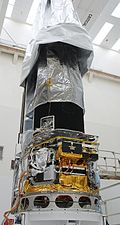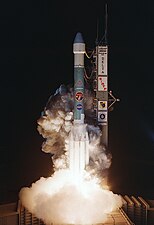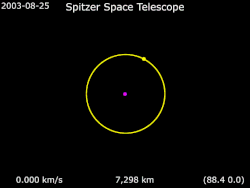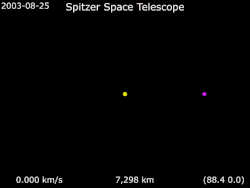Spitzer Space Telescope
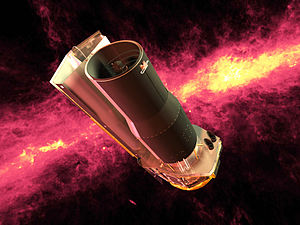 An artist rendering of the Spitzer Space Telescope | |||||||||
| Names | Space Infrared Telescope Facility | ||||||||
|---|---|---|---|---|---|---|---|---|---|
| Mission type | Infraredspace telescope | ||||||||
| Operator | NASA/JPL/Caltech | ||||||||
| COSPAR ID | 2003-038A | ||||||||
| SATCATno. | 27871 | ||||||||
| Website | spitzer.caltech.edu | ||||||||
| Mission duration | Planned: 2.5 to 5+ years[1] Primary mission: 5 years, 8 months, 19 days Final: 16 years, 5 months, 4 days | ||||||||
| Spacecraft properties | |||||||||
| Manufacturer | Lockheed Ball Aerospace | ||||||||
| Launch mass | 950 kg (2,094 lb)[1] | ||||||||
| Dry mass | 884 kg (1,949 lb) | ||||||||
| Payload mass | 851.5 kg (1,877 lb)[1] | ||||||||
| Power | 427 W[2] | ||||||||
| Start of mission | |||||||||
| Launch date | 25 August 2003, 05:35:39UTC[3] | ||||||||
| Rocket | Delta II7920H[4] | ||||||||
| Launch site | Cape CanaveralSLC-17B | ||||||||
| Entered service | 18 December 2003 | ||||||||
| End of mission | |||||||||
| Disposal | Deactivated in Earth-trailing orbit | ||||||||
| Deactivated | 30 January 2020[5] | ||||||||
| Orbital parameters | |||||||||
| Reference system | Heliocentric[1] | ||||||||
| Regime | Earth-trailing[1] | ||||||||
| Eccentricity | 0.011[6] | ||||||||
| Perihelion altitude | 1.003AU[6] | ||||||||
| Aphelion altitude | 1.026 AU[6] | ||||||||
| Inclination | 1.13°[6] | ||||||||
| Period | 373.2 days[6] | ||||||||
| Epoch | 16 March 2017 00:00:00 | ||||||||
| Main telescope | |||||||||
| Type | Ritchey–Chrétien[7] | ||||||||
| Diameter | 0.85 m (2.8 ft)[1] | ||||||||
| Focal length | 10.2 m (33 ft) | ||||||||
| Wavelengths | infrared,3.6–160μm[8] | ||||||||
| |||||||||

| |||||||||
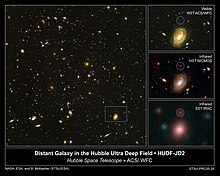
TheSpitzer Space Telescope,formerly theSpace Infrared Telescope Facility(SIRTF), is aninfraredspace telescopelaunched in 2003, that was deactivated when operations ended on 30 January 2020.[5][9]Spitzer was the third space telescope dedicated to infrared astronomy, followingIRAS(1983) andISO(1995–1998). It was the first spacecraft to use anEarth-trailing orbit,later used by theKeplerplanet-finder.
The planned mission period was to be 2.5 years with a pre-launch expectation that the mission could extend to five or slightly more years until the onboardliquid heliumsupply was exhausted. This occurred on 15 May 2009.[10]Without liquid helium to cool the telescope to the very low temperatures needed to operate, most of the instruments were no longer usable. However, the two shortest-wavelength modules of theIRACcamera continued to operate with the same sensitivity as before the helium was exhausted, and continued to be used into early 2020 in theSpitzer Warm Mission.[11][12]
During the warm mission, the two short wavelength channels of IRAC operated at 28.7 K and were predicted to experience little to no degradation at this temperature compared to the nominal mission. The Spitzer data, from both the primary and warm phases, are archived at theInfrared Science Archive(IRSA).
In keeping with NASA tradition, the telescope was renamed after its successful demonstration of operation, on 18 December 2003. Unlike mosttelescopesthat are named by a board of scientists, typically after famous deceased astronomers, the new name for SIRTF was obtained from a contest open to the general public. The contest led to the telescope being named in honor of astronomerLyman Spitzer,who had promoted the concept of space telescopes in the 1940s.[13]Spitzer wrote a 1946 report forRAND Corporationdescribing the advantages of an extraterrestrial observatory and how it could be realized with available or upcoming technology.[14][15]He has been cited for his pioneering contributions torocketryandastronomy,as well as "his vision and leadership in articulating the advantages and benefits to be realized from the Space Telescope Program."[13]
TheUS$776 million[16]Spitzer was launched on 25 August 2003 at 05:35:39UTCfromCape CanaveralSLC-17Baboard aDelta II7920H rocket.[3]It was placed into aheliocentric(as opposed to ageocentric) orbit trailing and drifting away from Earth's orbit at approximately 0.1astronomical unitsper year (an"Earth-trailing" orbit[1]).
Theprimary mirroris 85 centimeters (33 in) in diameter,f/12,made ofberylliumand was cooled to 5.5K(−268 °C; −450 °F). Thesatellitecontains three instruments that allowed it to perform astronomical imaging andphotometryfrom 3.6 to 160 micrometers,spectroscopyfrom 5.2 to 38 micrometers, andspectrophotometryfrom 55 to 95 micrometers.[8]
History[edit]
This sectionneeds additional citations forverification.(January 2020) |
By the early 1970s, astronomers began to consider the possibility of placing aninfrared telescopeabove the obscuring effects of Earth's atmosphere. In 1979, a report from the National Research Council of theNational Academy of Sciences,A Strategy for Space Astronomy and Astrophysics for the 1980s,identified a Shuttle Infrared Telescope Facility (SIRTF)[17]as "one of two major astrophysics facilities [to be developed] forSpacelab",a shuttle-borne platform. Anticipating the major results from an upcoming Explorer satellite and from the Shuttle mission, the report also favored the" study and development of... long-duration spaceflights of infrared telescopes cooled to cryogenic temperatures[18]."
The launch in January 1983 of theInfrared Astronomical Satellite,jointly developed by the United States, the Netherlands, and the United Kingdom, to conduct the first infrared survey of the sky, whetted the appetites of scientists worldwide for follow-up space missions capitalizing on the rapid improvements in infrared detector technology.
Earlier infrared observations had been made by both space-based and ground-basedobservatories.Ground-based observatories have the drawback that at infraredwavelengthsorfrequencies,both the Earth'satmosphereand the telescope itself will radiate (glow) brightly. Additionally, the atmosphere is opaque at most infrared wavelengths. This necessitates lengthy exposure times and greatly decreases the ability to detect faint objects. It could be compared to trying to observe the stars in the optical at noon from a telescope built out of light bulbs. Previous space observatories (such asIRAS,the Infrared Astronomical Satellite, andISO,the Infrared Space Observatory) were launched during the 1980s and 1990s and great advances in astronomical technology have been made since then.
Most of the early concepts envisioned repeated flights aboard the NASA Space Shuttle. This approach was developed in an era when the Shuttle program was expected to support weekly flights of up to 30 days duration. A May 1983 NASA proposal described SIRTF as a Shuttle-attached mission, with an evolving scientific instrument payload. Several flights were anticipated with a probable transition into a more extended mode of operation, possibly in association with a future space platform or space station. SIRTF would be a 1-meter class, cryogenically cooled, multi-user facility consisting of a telescope and associated focal plane instruments. It would be launched on the Space Shuttle and remain attached to the Shuttle as a Spacelab payload during astronomical observations, after which it would be returned to Earth for refurbishment prior to re-flight. The first flight was expected to occur about 1990, with the succeeding flights anticipated beginning approximately one year later. However, the Spacelab-2 flight aboardSTS-51-Fshowed that the Shuttle environment was poorly suited to an onboard infrared telescope due to contamination from the relatively "dirty" vacuum associated with the orbiters. By September 1983, NASA was considering the "possibility of a long duration [free-flyer] SIRTF mission".[19][20]
Spitzer is the only one of theGreat Observatoriesnot launched by theSpace Shuttle,as was originally intended[citation needed].However, after the 1986Challenger disaster,theShuttle-Centaurupper stage, which would have been required to place it into its final orbit, was abandoned. The mission underwent a series of redesigns during the 1990s, primarily due to budget considerations. This resulted in a much smaller but still fully capable mission that could use the smaller Delta II expendable launch vehicle.[21]
One of the most important advances of this redesign was anEarth-trailing orbit.[1]Cryogenic satellites that require liquid helium (LHe, T ≈ 4 K) temperatures in near-Earth orbit are typically exposed to a large heat load from Earth, and consequently require large amounts of LHe coolant, which then tends to dominate the total payload mass and limits mission life. Placing the satellite in solar orbit far from Earth allowed innovative passive cooling. The sun shield protected the rest of the spacecraft from the Sun's heat, the far side of the spacecraft was painted black to enhance passive radiation of heat, and the spacecraft bus was thermally isolated from the telescope. All of these design choices combined to drastically reduce the total mass of helium needed, resulting in an overall smaller and lighter payload, resulting in major cost savings, but with a mirror the same diameter as originally designed. This orbit also simplified telescope pointing, but did require theNASA Deep Space Networkfor communications.[citation needed]
The primary instrument package (telescope and cryogenic chamber) was developed byBall Aerospace & Technologies,inBoulder, Colorado.The individual instruments were developed jointly by industrial, academic, and government institutions. The principals wereCornell University,theUniversity of Arizona,theSmithsonian Astrophysical Observatory,Ball Aerospace,andGoddard Spaceflight Center.The shorter-wavelength infrared detectors were developed byRaytheoninGoleta, California.Raytheon usedindium antimonideand adopedsilicondetector in the creation of the infrared detectors. These detectors are 100 times more sensitive than what was available at the beginning of the project during the 1980s.[22]The far-infrared detectors (70–160 micrometers) were developed jointly by the University of Arizona andLawrence Berkeley National Laboratoryusinggallium-dopedgermanium.The spacecraft was built byLockheed Martin.The mission was operated and managed by theJet Propulsion Laboratoryand theSpitzer Science Center,[23]located at IPAC on theCaltechcampus in Pasadena, California.[citation needed]
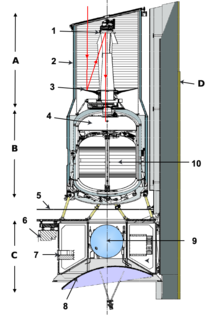
A Optics:1 - secondary mirror; 3 - primary mirror; 2 - outer shell;
B Cryostat:4 - instruments; 10 - helium tank;
C Service module:5 - service module shield; 6 - star tracker; 7 - batteries; 8 - high-gain antenna; 9 - nitrogen tank;
D Solar panels
Launch and commissioning[edit]
This section is empty.You can help byadding to it.(December 2021) |
Warm mission and end of mission[edit]
Spitzer ran out of liquid helium coolant on 15 May 2009, which stopped far-IR observations. Only the IRAC instrument remained in use, and only at the two shorter wavelength bands (3.6 μm and 4.5 μm). The telescope equilibrium temperature was then around 30 K (−243 °C; −406 °F), and IRAC continued to produce valuable images at those wavelengths as the "Spitzer Warm Mission".[24]
Late in the mission, ~2016, Spitzer's distance to Earth and the shape of its orbit meant the spacecraft had to pitch over at an extreme angle to aim its antenna at Earth.[25]The solar panels were not fully illuminated at this angle, and this limited those communications to 2.5 hours due to the battery drain.[26]The telescope was retired on 30 January 2020[5]when NASA sent a shutdown signal to the telescope from theGoldstone Deep Space Communications Complex(GDSCC) instructing the telescope to go into safe mode.[27]After receiving confirmation that the command was successful, Spitzer Project Manager Joseph Hunt officially declared that the mission had ended.[28]
Instruments[edit]
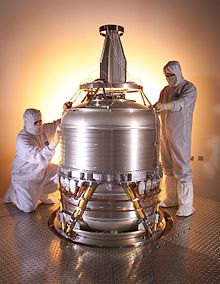
Spitzer carries three instruments on board:[29][30][31][32]
- Infrared Array Camera(IRAC)
- An infrared camera which operated simultaneously on four wavelengths (3.6 μm, 4.5 μm, 5.8 μm and 8 μm). Each module used a 256×256-pixel detector—the short-wavelength pair usedindium antimonidetechnology, the long-wavelength pair used arsenic-doped siliconimpurity band conductiontechnology.[33]The principal investigator wasGiovanni FazioofCenter for Astrophysics | Harvard & Smithsonian;the flight hardware was built byNASAGoddard Space Flight Center.
- Infrared Spectrograph (IRS)
- An infrared spectrometer with four sub-modules which operate at the wavelengths 5.3–14 μm (low resolution), 10–19.5 μm (high resolution), 14–40 μm (low resolution), and 19–37 μm (high resolution). Each module used a 128×128-pixel detector—the short-wavelength pair used arsenic-doped silicon blocked impurity band technology, the long-wavelength pair used antimony-doped silicon blocked impurity band technology.[34]The principal investigator wasJames R. HouckofCornell University;the flight hardware was built byBall Aerospace.
- Multiband Imaging Photometer for Spitzer (MIPS)
- Three detector arrays in the mid- to far-infrared (128 × 128 pixels at 24μm,32 × 32 pixels at 70 μm, 2 × 20 pixels at 160 μm). The 24 μm detector is identical to one of the IRS short-wavelength modules. The 70 μm detector used gallium-doped germanium technology, and the 160 μm detector also used gallium-doped germanium, but with mechanical stress added to each pixel to lower the bandgap and extend sensitivity to this long-wavelength.[35]The principal investigator wasGeorge H. Riekeof theUniversity of Arizona;the flight hardware was built byBall Aerospace.
All three instruments used liquid helium for cooling the sensors. Once the helium was exhausted, only the two shorter wavelengths in IRAC were used in the "warm mission".
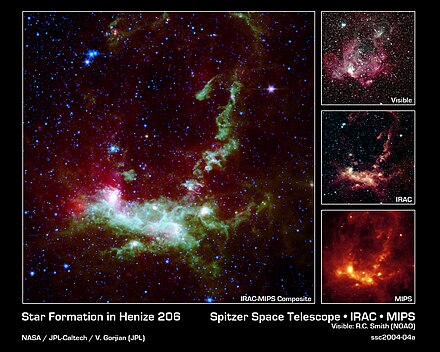
Results[edit]
While some time on the telescope was reserved for participating institutions and crucial projects, astronomers around the world also had the opportunity to submit proposals for observing time. Prior to launch, there was a proposal call for large, coherent investigations using Spitzer. If the telescope failed early and/or ran out of cryogen very quickly, these so-called Legacy Projects would ensure the best possible science could be obtained quickly in the early months of the mission. As a requirement tied to the funding these Legacy teams received, the teams had to deliver high-level data products back to the Spitzer Science Center (and theNASA/IPAC Infrared Science Archive) for use by the community, again ensuring the rapid scientific return of the mission. The international scientific community quickly realized the value of delivering products for others to use, and even though Legacy projects were no longer explicitly solicited in subsequent proposal calls, teams continued to deliver products to the community. The Spitzer Science Center later reinstated named "Legacy" projects (and later still "Exploration Science" projects) in response to this community-driven effort.[36]
Important targets included forming stars (young stellar objects,or YSOs), planets, and other galaxies. Images are freely available for educational and journalistic purposes.[37][38]
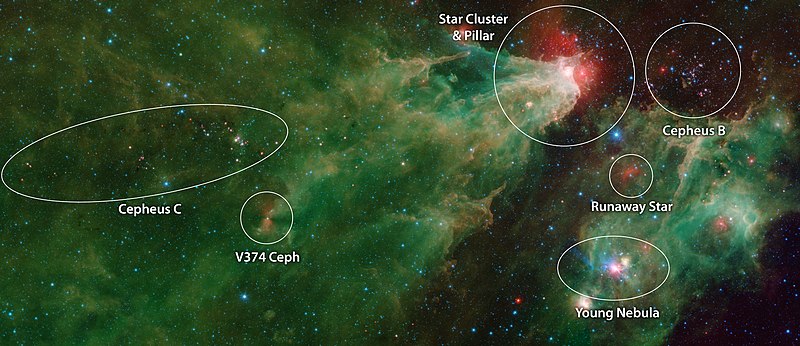

The first released images from Spitzer were designed to show off the abilities of the telescope and showed a glowing stellar nursery, a big swirling, dustygalaxy,a disc of planet-forming debris, and organic material in the distant universe. Since then, many monthly press releases have highlighted Spitzer'scapabilities, as the NASA andESAimages do for theHubble Space Telescope.
As one of its most noteworthy observations, in 2005, Spitzer became one of the first telescopes to directly capture light fromexoplanets,namely the "hot Jupiters"HD 209458 bandTrES-1b,although it did not resolve that light into actual images.[39]This was one of the first times the light from extrasolar planets had been directly detected; earlier observations had been indirectly made by drawing conclusions from behaviors of the stars the planets were orbiting. The telescope also discovered in April 2005 thatCohen-kuhi Tau/4had a planetary disk that was vastly younger and contained less mass than previously theorized, leading to new understandings of how planets are formed.
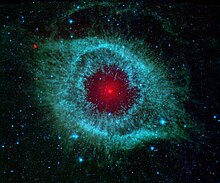
In 2004, it was reported that Spitzer had spotted a faintly glowing body that may be the youngest star ever seen. The telescope was trained on a core of gas and dust known asL1014which had previously appeared completely dark to ground-based observatories and to ISO (Infrared Space Observatory), a predecessor to Spitzer. The advanced technology of Spitzer revealed a bright red hot spot in the middle of L1014.
Scientists from theUniversity of Texas at Austin,who discovered the object, believe the hot spot to be an example of early star development, with the young star collecting gas and dust from the cloud around it. Early speculation about the hot spot was that it might have been the faint light of another core that lies 10 times further from Earth but along the same line of sight as L1014. Follow-up observation from ground-based near-infrared observatories detected a faint fan-shaped glow in the same location as the object found by Spitzer. That glow is too feeble to have come from the more distant core, leading to the conclusion that the object is located within L1014. (Younget al.,2004)
In 2005, astronomers from theUniversity of WisconsinatMadisonandWhitewaterdetermined, on the basis of 400 hours of observation on the Spitzer Space Telescope, that theMilky Waygalaxy has a more substantialbar structureacross its core than previously recognized.
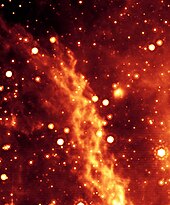
Also in 2005, astronomersAlexander KashlinskyandJohn Matherof NASA'sGoddard Space Flight Centerreported that one of Spitzer'searliest images may have captured the light of the first stars in the universe. An image of aquasarin theDracoconstellation,intended only to helpcalibratethe telescope, was found to contain an infrared glow after the light of known objects was removed. Kashlinsky and Mather are convinced that the numerous blobs in this glow are the light of stars that formed as early as 100 million years after theBig Bang,redshiftedbycosmic expansion.[40]
In March 2006, astronomers reported an 80-light-yearlong (25pc) nebula near the center of the Milky Way Galaxy, theDouble Helix Nebula,which is, as the name implies, twisted into a double spiral shape. This is thought to be evidence of massive magnetic fields generated by the gas disc orbiting thesupermassive black holeat the galaxy's center, 300 light-years (92 pc) from the nebula and 25,000 light-years (7,700 pc) from Earth. This nebula was discovered by Spitzer and published in the magazineNatureon 16 March 2006.
In May 2007, astronomers successfully mapped the atmospheric temperature ofHD 189733 b,thus obtaining the first map of some kind of an extrasolar planet.
Starting in September 2006, the telescope participated in a series of surveys called theGould Belt Survey,observing theGould's Beltregion in multiple wavelengths. The first set of observations by the Spitzer Space Telescope was completed from 21 September 2006 through 27 September. Resulting from these observations, the team of astronomers led by Dr. Robert Gutermuth, of theCenter for Astrophysics | Harvard & Smithsonianreported the discovery ofSerpens South,a cluster of 50 young stars in theSerpensconstellation.

Scientists have long wondered how tiny silicate crystals, which need high temperatures to form, have found their way into frozen comets, born in the very cold environment of the Solar System's outer edges. The crystals would have begun as non-crystallized, amorphous silicate particles, part of the mix of gas and dust from which the Solar System developed. This mystery has deepened with the results of theStardustsample return mission, which captured particles from CometWild 2.Many of the Stardust particles were found to have formed at temperatures in excess of 1,000 K.
In May 2009, Spitzer researchers from Germany, Hungary, and the Netherlands found that amorphous silicate appears to have been transformed into crystalline form by an outburst from a star. They detected the infrared signature offorsteritesilicate crystals on the disk of dust and gas surrounding the star EX Lupi during one of its frequent flare-ups, or outbursts, seen by Spitzer in April 2008. These crystals were not present in Spitzer'sprevious observations of the star's disk during one of its quiet periods. These crystals appear to have formed by radiative heating of the dust within 0.5 AU of EX Lupi.[41][42]
In August 2009, the telescope found evidence of a high-speed collision between two burgeoning planets orbiting a young star.[43]
In October 2009, astronomers Anne J. Verbiscer, Michael F. Skrutskie, and Douglas P. Hamilton published findings of the "Phoebe ring"ofSaturn,which was found with the telescope; the ring is a huge, tenuous disc of material extending from 128 to 207 times the radius of Saturn.[44]
GLIMPSE and MIPSGAL surveys[edit]
GLIMPSE, theGalactic Legacy Infrared Mid-Plane Survey Extraordinaire,was a series of surveys that spanned 360° of the inner region of the Milky Way galaxy, which provided the first large-scale mapping of the galaxy.[45][46]It consists of more than 2 million snapshots taken in four separate wavelengths using the Infrared Array Camera.[47]The images were taken over a 10-year period beginning in 2003 when Spitzer launched.[48]
MIPSGAL, a similar survey that complements GLIMPSE, covers 248° of the galactic disk[49]using the 24 and 70 μm channels of the MIPS instrument.[50]
On 3 June 2008, scientists unveiled the largest, most detailed infrared portrait of theMilky Way,created by stitching together more than 800,000 snapshots, at the 212th meeting of theAmerican Astronomical SocietyinSt. Louis,Missouri.[51][52]This composite survey is now viewable with the GLIMPSE/MIPSGAL Viewer.[53]
2010s[edit]

Spitzer observations, announced in May 2011, indicate that tinyforsteritecrystals might be falling down like rain on to theprotostarHOPS-68. The discovery of the forsterite crystals in the outer collapsing cloud of the protostar is surprising because the crystals form at lava-like high temperatures, yet they are found in the molecular cloud where the temperatures are about −170 °C (103 K; −274 °F). This led the team of astronomers to speculate that thebipolar outflowfrom the young star may be transporting the forsterite crystals from near the star's surface to the chilly outer cloud.[54][55]
In January 2012, it was reported that further analysis of the Spitzer observations of EX Lupi can be understood if the forsterite crystalline dust was moving away from the protostar at a remarkable average speed of 38 kilometres per second (24 mi/s). It would appear that such high speeds can arise only if the dust grains had been ejected by a bipolar outflow close to the star.[56]Such observations are consistent with an astrophysical theory, developed in the early 1990s, where it was suggested that bipolar outflows garden or transform the disks of gas and dust that surround protostars by continually ejecting reprocessed, highly heated material from the inner disk, adjacent to the protostar, to regions of the accretion disk further away from the protostar.[57]
In April 2015, Spitzer and theOptical Gravitational Lensing Experimentwere reported as co-discovering one of the most distant planets ever identified: a gas giant about 13,000 light-years (4,000 pc) away from Earth.[58]
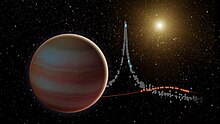
In June and July 2015, thebrown dwarfOGLE-2015-BLG-1319was discovered using thegravitational microlensingdetection method in a joint effort betweenSwift,Spitzer, and the ground-basedOptical Gravitational Lensing Experiment,the first time two space telescopes have observed the same microlensing event. This method was possible because of the large separation between the two spacecraft: Swift is in low-Earth orbit while Spitzer is more than oneAUdistant in an Earth-trailing heliocentric orbit.[1]This separation provided significantly different perspectives of the brown dwarf, allowing for constraints to be placed on some of the object's physical characteristics.[59]
Reported in March 2016, Spitzer and Hubble were used to discover the most distant-known galaxy,GN-z11.This object was seen as it appeared 13.4 billion years ago.[60][25]
Spitzer Beyond[edit]
On 1 October 2016, Spitzer began its Observation Cycle 13, a2+1⁄2year extended mission nicknamedBeyond.One of the goals of this extended mission was to help prepare for theJames Webb Space Telescope,also an infrared telescope, by identifying candidates for more detailed observations.[25]
Another aspect of theBeyondmission was the engineering challenges of operating Spitzer in its progressing orbital phase. As the spacecraft moved farther from Earth on the same orbital path from the Sun, its antenna had to point at increasingly higher angles to communicate with ground stations; this change in angle imparted more and more solar heating on the vehicle while its solar panels received less sunlight.[25]
Planet hunter[edit]
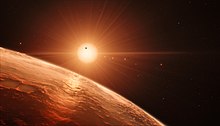
Spitzer was also put to work studying exoplanets thanks to creatively tweaking its hardware. This included doubling its stability by modifying its heating cycle, finding a new use for the "peak-up" camera, and analyzing the sensor at a sub-pixel level. Although in its "warm" mission, the spacecraft's passive cooling system kept the sensors at 29 K (−244 °C; −407 °F).[61]Spitzer used thetransit photometryandgravitational microlensingtechniques to perform these observations.[25]According to NASA's Sean Carey, "We never even considered using Spitzer for studying exoplanets when it launched.... It would have seemed ludicrous back then, but now it's an important part of what Spitzer does."[25]
Examples of exoplanets discovered using Spitzer includeHD 219134 bin 2015, which was shown to be a rocky planet about 1.5 times as large as Earth in a three-day orbit around its star;[62]and an unnamed planet found using microlensing located about 13,000 light-years (4,000 pc) from Earth.[63]
In September–October 2016, Spitzer was used to discover five of a total of seven known planets around the starTRAPPIST-1,all of which are approximately Earth-sized and likely rocky.[64][65]Three of the discovered planets are located in thehabitable zone,which means they are capable of supportingliquid watergiven sufficient parameters.[66]Using thetransit method,Spitzer helped measure the sizes of the seven planets and estimate the mass and density of the inner six. Further observations will help determine if there is liquid water on any of the planets.[64]
See also[edit]
- Herschel Space Observatory(2009–2013)
- Infrared astronomy
- List of deep fields
- List of space telescopes
- List of largest infrared telescopes
References[edit]
- ^abcdefghi"About Spitzer: Fast Facts".Jet Propulsion Laboratory.2008.Archivedfrom the original on 3 October 2023.Retrieved22 April2007.
- ^"The Solar Panel Assembly".Jet Propulsion Laboratory.Archivedfrom the original on 28 September 2023.
- ^abHarwood, William (25 August 2003)."300th Delta rocket launches new window on Universe".Spaceflight Now forCBS News.Archivedfrom the original on 21 March 2023.Retrieved1 December2016.
- ^"Spitzer Space Telescope: Launch/Orbital Information".National Space Science Data Center.2003-038A.Archivedfrom the original on 24 September 2023.Retrieved26 April2015.
- ^abcEnding in 2020, NASA's Infrared Spitzer Mission Leaves a Gap in Astronomy.Jonathan O'Callaghan.Scientific American.June 4, 2019.
- ^abcde"HORIZONS Web-Interface".Jet Propulsion Laboratory.Retrieved16 March2017.
- ^"About Spitzer: Spitzer's Telescope".Jet Propulsion Laboratory.Archivedfrom the original on 3 October 2023.Retrieved22 April2007.
- ^abVan Dyk, Schuyler; Werner, Michael; Silbermann, Nancy (March 2013) [2010]."3.2: Observatory Description".Spitzer Telescope Handbook.Infrared Science Archive.Archivedfrom the original on 10 April 2023.Retrieved18 October2015.
- ^Mann, Adam (30 January 2020)."NASA's Spitzer Space Telescope Ends 16-Year Mission of Discovery".The New York Times.Archivedfrom the original on 2 August 2023.Retrieved4 February2020.
- ^Clavin, Whitney (15 May 2009)."NASA's Spitzer Begins Warm Mission"(Press release). Pasadena, California:Jet Propulsion Laboratory.ssc2009-12, jpl2009-086.Archivedfrom the original on 3 January 2024.Retrieved26 April2015.
- ^Stauffer, John R.; Mannings, Vincent; Levine, Deborah; Chary, Ranga Ram; Wilson, Gillian; Lacy, Mark; Grillmair, Carl; Carey, Sean; Stolovy, Susan (August 2007).The Spitzer Warm Mission Science Prospects(PDF).Spitzer Warm Mission Workshop.AIP Conference Proceedings.Vol. 943.American Institute of Physics.pp. 43–66.Bibcode:2007AIPC..943...43S.doi:10.1063/1.2806787.Archived(PDF)from the original on 27 December 2023.
- ^"Cycle-6 Warm Mission".Spitzer Science Center.Jet Propulsion Laboratory.Archived fromthe originalon 4 July 2010.Retrieved16 September2009.
- ^abApplewhite, Denise (11 March 2004)."Lyman Spitzer Jr".Jet Propulsion Laboratory&Princeton University.Archivedfrom the original on 21 January 2024.Retrieved6 January2009.
- ^Carolyn Collins Petersen; John C. Brandt (1998).Hubble vision: further adventures with the Hubble Space Telescope.CUP Archive. p.193.ISBN978-0-521-59291-8.
- ^Zimmerman, Robert (2008).The universe in a mirror: the saga of the Hubble Telescope and the visionaries who built it.Princeton University Press. p.10.ISBN978-0-691-13297-6.
- ^"Spitzer Space Telescope Fast Facts".Jet Propulsion Laboratory.Archivedfrom the original on 14 February 2024.Retrieved21 August2020.
- ^"Strategy and Recommendations".Strategy for Space Astronomy and Astrophysics for the 1980's (Report). TheNational Academies Press.1979. p. 19.doi:10.17226/19837.ISBN978-0-309-33285-9.
- ^Astronomy and Astrophysics for the 1980's, Volume 1: Report of the Astronomy Survey Committee).TheNational Academies Press.1982. p. 54.doi:10.17226/549.hdl:2060/19830018496.ISBN978-0-309-03249-0.
- ^Watanabe, Susan (22 November 2007)."Studying the Universe in Infrared".NASA.Archived fromthe originalon 7 July 2019.Retrieved8 December2007.
- ^Kwok, Johnny (1 October 2006)."Finding a Way: The Spitzer Space Telescope Story".NASA ASK Magazine.No. 25.NASA.Archivedfrom the original on 25 September 2022.Retrieved9 December2007.
- ^Rieke, George (2006).The Last of the Great Observatories: Spitzer and the Era of Faster, Better, Cheaper at NASA.The University of Arizona Press. p.[1].ISBN0-8165-2558-7.
- ^Kopec, Janet, ed. (8 January 2004)."Raytheon Technology Enables Superior Space Images From Spitzer Space Telescope"(Press release).Raytheon.Archivedfrom the original on 9 August 2018.
- ^Spitzer Science Center Home Page -- Public information.
- ^Clavin, Whitney B.; Harrington, J. D. (5 August 2009)."NASA's Spitzer Sees the Cosmos Through 'Warm' Infrared Eyes"(Press release).NASA.2009-116.Archivedfrom the original on 26 March 2023.Retrieved30 January2016.
- ^abcdefLandau, Elizabeth (25 August 2016)."Spitzer Space Telescope Begins 'Beyond' Phase"(Press release).Jet Propulsion Laboratory.2016-221.Archivedfrom the original on 20 February 2024.Retrieved9 December2016.
- ^Cofield, Calla, ed. (13 June 2019)."How NASA's Spitzer Has Stayed Alive for So Long"(Press release).Jet Propulsion Laboratory.ssc2019-10.Archivedfrom the original on 1 February 2024.
- ^Oberhaus, Daniel (29 January 2020)."RIP Spitzer, the Coolest Heat Telescope in the Solar System".Wired.Archivedfrom the original on 24 July 2023.Retrieved29 January2020.
- ^Hautaluoma, Grey; Landau, Elizabeth; Cofield, Calla, eds. (30 January 2020)."NASA's Spitzer Space Telescope Ends Mission of Astronomical Discovery"(Press release).Jet Propulsion Laboratory.ssc2020-08.Archivedfrom the original on 1 February 2024.Retrieved10 February2020.
- ^"SSC Observatory general information page".Jet Propulsion Laboratory.Archived fromthe originalon 6 February 2010.Retrieved4 October2009.
- ^"SSC Observatory Overview".Jet Propulsion Laboratory.Archived fromthe originalon 10 October 2009.Retrieved4 October2009.
- ^SSC Science Information home page,4 October 2009.
- ^"Spitzer Observers' Manual - reference for technical instrument information, Ver 8".Archived fromthe originalon 11 October 2009.Retrieved15 August2008.
- ^"SSC IRAC (Mid IR camera) science users information page".Jet Propulsion Laboratory.Archived fromthe originalon 1 November 2009.Retrieved4 October2009.
- ^"SSC IRS (spectrometer) science users' information page".Jet Propulsion Laboratory.Archived fromthe originalon 3 August 2009.Retrieved4 October2009.
- ^"SSC MIPS (long wavelength 24um, 70um, & 160um) imaging photometer and spectrometer science users' information page".Jet Propulsion Laboratory.Archived fromthe originalon 8 November 2009.
- ^"Spitzer Documentation & Tools: Legacy Programs".NASA/IPAC Infrared Science Archive.NASA.Archivedfrom the original on 10 December 2023.Retrieved26 August2020.
- ^"IPAC Image Use Policy".NASAIPAC.Archivedfrom the original on 1 February 2024.Retrieved26 August2020.
- ^"Spitzer Space Telescope Images".Astropix.Retrieved26 August2020.
- ^Press Release: NASA's Spitzer Marks Beginning of New Age of Planetary Science.
- ^Infrared Glow of First Stars Found: Scientific AmericanArchived10 October 2007 at theWayback Machine.
- ^Clavin, Whitney (ed.)."Spitzer Catches Star Cooking Up Comet Crystals"(Press release).Jet Propulsion Laboratory.2009-083.Archivedfrom the original on 7 January 2024.
- ^Ábrahám, P.; et al. (14 May 2009). "Episodic formation of cometary material in the outburst of a young Sun-like star".Nature.459(7244): 224–226.arXiv:0906.3161.Bibcode:2009Natur.459..224A.doi:10.1038/nature08004.PMID19444209.S2CID4426934.
- ^"Traces of planet collision found".BBC News.11 August 2009.Archivedfrom the original on 10 December 2023.
- ^Verbiscer, Anne; Michael Skrutskie; Douglas Hamilton (7 October 2009). "Saturn's largest ring".Nature.461(7267): 1098–100.Bibcode:2009Natur.461.1098V.doi:10.1038/nature08515.PMID19812546.S2CID4349726.
- ^"NASA's Spitzer Telescope Brings 360-Degree View of Galaxy to Our Fingertips"(Press release).Jet Propulsion Laboratory.20 March 2014. ssc2014-02.Archivedfrom the original on 28 September 2023.
- ^Cofield, Calla, ed. (25 August 2020)."Where Are Stars Made? NASA's Spitzer Spies a Hot Spot"(Press release).NASA&Jet Propulsion Laboratory.ssc2020-14.Archivedfrom the original on 26 February 2024.Retrieved31 August2020.
- ^Galactic Legacy Infrared Mid-Plane Survey ExtraordinaireArchived8 May 2021 at theWayback Machine,University of Wisconsin–Madison Department of Astronomy
- ^"GLIMPSE the Galaxy All the Way Around"(Press release).Jet Propulsion Laboratory.20 March 2014. ssc2014-02a.Archivedfrom the original on 26 December 2023.Retrieved26 August2020.
- ^"A 24 and 70 Micron Survey of the Inner Galactic Disk with MIPS (MIPSGAL) Data Collection Atlas".NASA/IPAC Infrared Science Archive (IRSA).Retrieved26 August2020.
- ^Werner, Michael; Eisenhardt, Peter (2019).More Things in the Heavens: How Infrared Astronomy is Expanding Our View of the Universe.Princeton University Press. p. 101.ISBN978-0-691-17554-6.
- ^Clavin, Whitney, ed. (3 June 2008)."Spitzer Captures Stellar Coming of Age in Our Galaxy".spitzer.caltech.edu(Press release).Jet Propulsion Laboratory.ssc2008-11, jpl2008-095.Archivedfrom the original on 28 September 2023.
- ^"Released Images and Videos of Milky Way Mosaic".Archived fromthe originalon 4 March 2016.Retrieved11 May2014.
- ^"Glimpse".alienearths.org.
- ^Clavin, Whitney; Perrotto, Trent, eds. (26 May 2011)."Spitzer Sees Crystal 'Rain' in Outer Clouds of Infant Star"(Press release).Jet Propulsion Laboratory.2011-161.Archivedfrom the original on 25 February 2024.
- ^Poteet, Charles A.; Megeath, S. Thomas; Watson, Dan M.; Calvet, Nuria; Remming, Ian S.; McClure, Melissa K.; Sargent, Benjamin A.; Fischer, William J.; Furlan, Elise;Allen, Lori E.;Bjorkman, Jon E.; Hartmann, Lee; Muzerolle, James; Tobin, John J.; Ali, Babar (June 2011)."A Spitzer Infrared Spectrograph Detection of Crystalline Silicates in a Protostellar Envelope"(PDF).The Astrophysical Journal Letters.733(2).American Astronomical Society:L32.arXiv:1104.4498.Bibcode:2011ApJ...733L..32P.doi:10.1088/2041-8205/733/2/L32.S2CID28545814.Archivedfrom the original on 26 February 2024.
- ^Juhász, A.; et al. (January 2012). "The 2008 Outburst of EX Lup—Silicate Crystals in Motion".The Astrophysical Journal.744(2): 118.arXiv:1110.3754.Bibcode:2012ApJ...744..118J.doi:10.1088/0004-637X/744/2/118.S2CID53550709.
- ^Liffman, K.; Brown, M. (October 1995). "The motion and size sorting of particles ejected from a protostellar accretion disk".Icarus.116(2): 275–290.Bibcode:1995Icar..116..275L.doi:10.1006/icar.1995.1126.
- ^Howell, Elizabeth (16 April 2015)."Newfound Alien Planet Is One of the Farthest Ever Detected".Space.Archivedfrom the original on 26 September 2023.Retrieved14 December2016.
- ^Landau, Elizabeth (10 November 2016)."NASA Space Telescopes Pinpoint Elusive Brown Dwarf".NASA / Jet Propulsion Laboratory.Retrieved18 December2016.
- ^"Hubble Team Breaks Cosmic Distance Record"(Press release).Jet Propulsion Laboratory.3 March 2016. feature16-04.Archivedfrom the original on 28 September 2023.Retrieved14 December2016.
- ^Hadhazy, Adam (24 September 2013)."How Engineers Revamped Spitzer to Probe Exoplanets"(Press release).Jet Propulsion Laboratory.2013-289.Archivedfrom the original on 28 March 2023.Retrieved14 December2016.
- ^Chou, Felicia; Clavin, Whitney B. (30 July 2015)."NASA's Spitzer Confirms Closest Rocky Exoplanet"(Press release).Jet Propulsion Laboratory.2015-251.Archivedfrom the original on 7 April 2023.Retrieved15 December2016.
- ^Clavin, Whitney B.; Chou, Felicia (14 April 2015)."NASA's Spitzer Spots Planet Deep Within Our Galaxy"(Press release).Jet Propulsion Laboratory.2015-128.Archivedfrom the original on 20 February 2024.Retrieved15 December2016.
- ^abChou, Felicia; Potter, Sean; Landau, Elizabeth (22 February 2017)."NASA Telescope Reveals Largest Batch of Earth-Size, Habitable-Zone Planets Around Single Star"(Press release).NASA.17-015.Archivedfrom the original on 16 February 2024.Retrieved3 March2017.
- ^Gillon, Michaël; et al. (23 February 2017)."Figure 1: The TRAPPIST-1 system as seen by Spitzer".Nature.542(7642): 456–460.arXiv:1703.01424.Bibcode:2017Natur.542..456G.doi:10.1038/nature21360.PMC5330437.PMID28230125.
- ^Kopparapu, Ravi Kumar (25 March 2013). "A revised estimate of the occurrence rate of terrestrial planets in the habitable zones around kepler m-dwarfs".The Astrophysical Journal Letters.767(1): L8.arXiv:1303.2649.Bibcode:2013ApJ...767L...8K.doi:10.1088/2041-8205/767/1/L8.S2CID119103101.
Further reading[edit]
- "A Spitzer retrospective".Nature.14 April 2020.
External links[edit]
 Media related toSpitzer Space Telescopeat Wikimedia Commons
Media related toSpitzer Space Telescopeat Wikimedia Commons- Spitzer Space Telescopeat NASA.gov
- Spitzer Space Telescopeat Caltech.edu
- Spitzer Space Telescopeby NASA's Solar System Exploration
- GLIMPSE/MIPSGAL image viewerat Alienearths.org
- "Spitzer Space Telescope: Discovering" More Things in the Heavens "with NASA's Spitzer Project Scientist Michael Werner",'Bridging the Gaps: A Portal for Curious Minds', 2019

